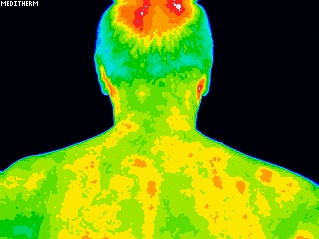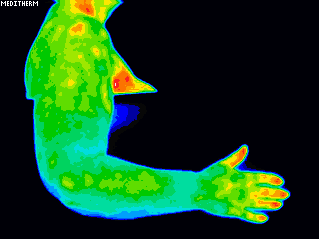
Tennis Elbow – hot or not?
So I wrote last week about the importance of getting the right diagnosis in cases of Tennis Elbow.
I spoke about the importance of a full assessment including the neck and shoulders to rule our referred pain as well as a full history to rule out any previous injuries or issues causing a compensation pattern.
But it is a hard problem to understand – I have pain here, why are you treating somewhere else? Patients often think I’m a bit mad. (I am but not when it comes to diagnosis!)
So what to do when your patient doesn’t believe you? Prove it.
Now in this case I had a handy husband and wife duo turn up who perfectly outlined my results. They BOTH had elbow pain which they thought was tennis elbow. On examination it turned out that while he did indeed have classic tennis elbow, what she had was referred pain from the neck.
And to help explain it I took them upstairs to my handy dandy Thermal Imaging camera! They have kindly said I can use their pictures to help explain.
This set is what classic tennis elbow looks like to my thermal imaging camera – although there is a little bit of heat (red spots) around the neck and upper back there isn’t anything very big or focused. And when we look at the elbow there is a very clear, very defined “hot” area over the outer elbow.
Now let’s look at the images of referred pain. At the neck we can see a very big, very defined “hot” spot just on the right side of her neck. We can also see that her right shoulder is higher than her left. These suggest we have a problem. And then we look at her right elbow where she is complaining of pain. No heat. In fact, the area is downright cold and blue, suggesting lack of nerve “activity” because of the blockage (that big hot spot!) at her neck/shoulder.
If I hadn’t investigated further, if I’d continued to treat where this lady complained of pain I would have had no effect whatsoever. I could have followed all the latest protocols and good advice and she would still have pain in her elbow.
As it is, I treated her neck and shoulder and it only took a couple of treatment sessions to stop her having pain in the elbow and a couple more (plus some homework for her!) to resolve the issue in her back.
Take the time to get the diagnosis right. Otherwise all you are doing is wasting your time and money and continuing to be in pain.





Sylvia Guest
January 5, 2020, 10:28 pm
Well – what a clever and so, so simple method of establishing where the issue lies. One of those ‘lightbulb’ moments – well done you!
Are you able to offer some advice on the best type of thermal imaging camera for this application please?
Estelle Mitchell
January 7, 2020, 1:22 pm
Hi Sylvia, there are specific thermal imaging cameras designed to be used in a clinical setting. I think my colleague has sent through more details via email for you.
Many thanks,